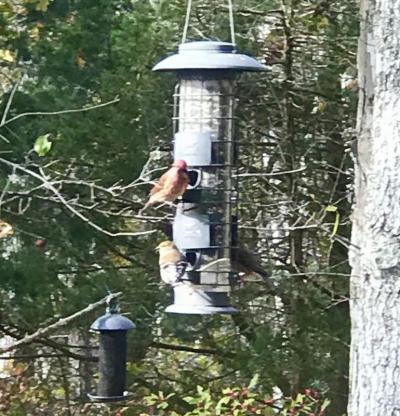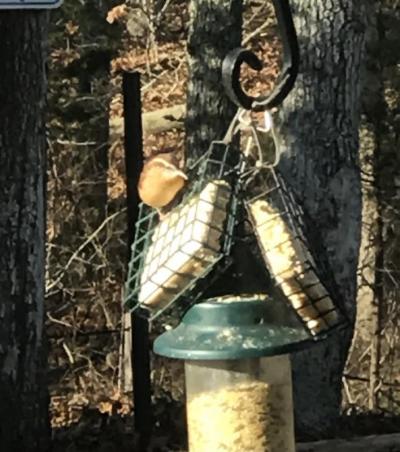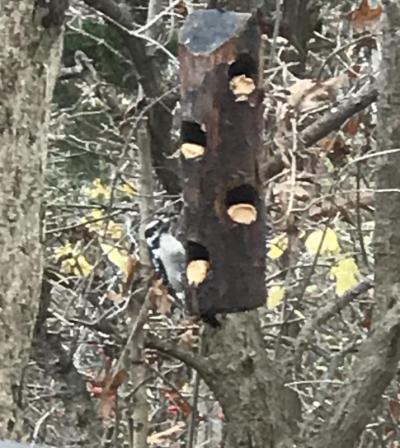Lloyd Center Begins Tenth Annual Feederwatch Season by Jamie Bogart, Lloyd Center Research Associate
This past late September and early October, the timeframe when later waves of fall migrant songbirds pass through the region, a yellow-rumped warbler appeared at our feeder area. Although many species have since come and gone, this is the one warbler species known to spend the winter in our region in high abundance. By November, many migrant songbird species that will also spend the winter here, some in great abundance, are filing through. Secretive species include the golden-crowned kinglets, which fill the coniferous woods but are difficult to spot, and brown creepers, which blend into the tree trunks that they crawl up. Species with a ground level niche at feeder areas include the dark-eyed juncos which have arrived, and the white-throated sparrows which are trickling in. Carolina wrens, a more resident species, are another hard to spot bird that becomes more visible in winter. Up in the tree canopy, roaming flocks of American robins pass through any given day in the hundreds, and numbers of blue jays are on the increase, both species featuring brighter-colored birds that have arrived from Canada.
Two species seen this year in late-October and early-November, purple finch and pine siskin, are especially noteworthy, as finches are to be seen any given winter at feeders, but which are in an “irruption” year. An irruption occurs when the cone seed crop is poor up north (likely due to drought conditions this year) and birds, especially the finch group, fly south in high numbers. Usually a purple finch or two visits the Lloyd Center’s feeders, but this season a few extras have shown up, and the species is at higher abundance region-wide. Pine siskin, a drabber and less robust version of the American Goldfinch, is identified by a slight yellow tinge on the outer wing, has only been documented here over the past decade in 2012 and 2016, during this same time of year. For those sightings a single individual was seen, but this season small flocks of siskins have appeared. The last time siskins were seen (2016), goldfinches, a familiar feeder bird but which also irrupts, were extremely abundant before showing very low abundance to this point in time. This season, both siskin and goldfinch numbers are higher, so subtle irruption signs exist.
Looking back over the past decade, the Lloyd Center has documented 41 total feeder species between the 2011-12 season and now. Much like the small snapshot here of fall migrants, the diversity ranges from some more common species like black-capped chickadees, and rarer sightings like common redpoll, which was last seen in February 2015, and is also irrupting this year.
Last season (2019-2020), we documented 25 species, with the most frequently encountered (using totals and birds per survey) ranked mourning dove, tufted titmouse, red-winged blackbird, common grackle, dark-eyed junco, and black-capped chickadee, all familiar feeder birds. Using average flock size when seen, the rankings were mourning dove, red-winged blackbird, common grackle, brown-headed cowbird, and tufted titmouse. Flock size accounts for groups such as the blackbirds, that while seen less frequently, all but overtake feeder stations when they are present. This past season a new Feederwatch species, the ruby-crowned kinglet, visited the feeders from January to March. Slightly less abundant here than its golden-crowned relative, this species is also small and inconspicuous and was entertaining to watch up close last season.
Last season was unique in that COVID-19 had more people at home observing their backyard feeders. For this reason, the Cornell Lab of Ornithology added the month of April to the Feederwatch season. Although the 15 species seen during April weren’t new, the highest number of individuals (79) was counted on April 21 due to high numbers of blackbirds. Red-winged blackbird was the most abundant bird, which comes as no surprise as their numbers increase considerably during the spring migration. Grackles and brown-headed cowbirds were close behind. The one evident change when adding April to the usual season (using totals and birds/survey) was the departure of dark-eyed juncos and a slight increase of brown-headed cowbirds, another blackbird increasing in spring.
For the rest of the northeast for last season (2019-2020), it was found that two species, northern flicker and eastern bluebird, appear to have shifted their ranges north. While bluebirds appeared only in the first season (2011-2012), what is likely a resident pair of northern flickers has been counted more frequently and in recent seasons. This species entered the top 25 list for the northeast region due possibly to the milder winters we’ve had, which as we know could be linked to climate change. During the April count for the northeast, a notable trend was that many sites had higher numbers of pileated woodpeckers at feeders, possibly due to dietary changes as breeding season approached (Cornell Feederwatch 2019-2020 summary). While we haven’t had a pileated (a forest interior species) at the Lloyd Center, the trend of changes in feeding habits that occur during the spring breeding season can be applied to other birds.
Our first count of the 2020-2021 season is complete, the temperatures started seasonable but plummeted quickly on day two. Highlights other than the usual species were a handful of both red-winged blackbirds which are passing through and American goldfinch which will likely spend the winter here. Juncos are increasing at ground level and a Carolina wren comes and goes, pecking away at the suet. The highlight however on the afternoon of day two was a brightly colored male purple finch, one of the “irrupting” species that stopped in for a bite.
Anyone possessing backyard bird feeders has reason to be more interested and excited than prior years as we anticipate how the finch irruption year will affect sightings, and again spend more time at home viewing feeders due to the pandemic. In these tough and uncertain times, we’re fortunate to have this valuable learning tool, Cornell’s Feederwatch, at our fingertips for quantifying feeder sightings and monitoring trends over time in our backyards. What other birds are on the way? The long winter ahead promises plenty of viewing opportunities and new discoveries.

















